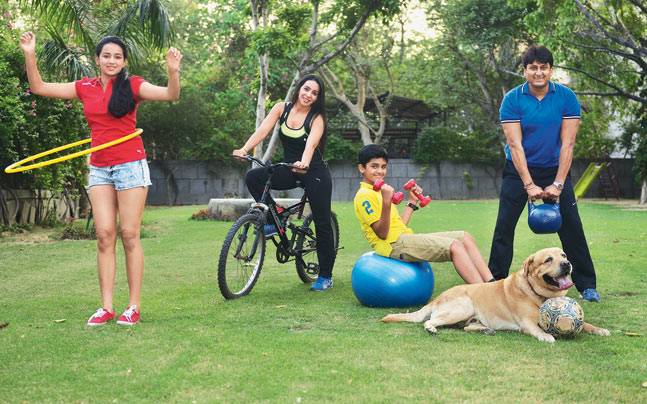By: Sandie Flynn Buller
Family fitness—exercising and otherwise living a healthy lifestyle – benefits not only your children and your own current and future health but also your family dynamic. By sharing physical activity and nutritious foods, your family can improve your health and enjoy your time together, creating bonds, memories and healthy habits.
According to the Centers for Disease Control and Prevention, “childhood obesity is a serious problem in the United States putting children and adolescents at risk for poor health.” Also, the Economic Institute in Washington DC has estimated that as many as 8 out of 10 children under the age of 7 are overweight, and another study has shown that ½ of all Americans between 12 – 21 years old are not physically active regularly. Perhaps more pertinent to acknowledge is the risk factor for childhood obesity, which directly leads to their chances of being obese as adults. Later in life, these children experience a greater risk for more serious health conditions that can be fatal. It has been well documented that children learn behavior early in life and they pattern themselves after the adults they look up to. As a parent, it’s your responsibility to safeguard your child’s health and wellbeing, and one of the best ways to do this is establishing healthy habits at an early age.
To reverse this trend, it is up to the family as a unit to become more active and perform exercise together while creating healthy habits that can last a lifetime. Those habits can provide lots of good things you probably already know about. Being physically active and eating well promote disease prevention, weight loss or maintenance, stress reduction, improved performance at school and work, increased longevity, and more. And if you and your children’s long-term health aren’t enough reasons family fitness should matter to you, consider these other top benefits of getting fit (and having fun) with your family:
1. Establish Lifelong Habits
Exercising and encouraging physical activity for your children is a surefire way to help them establish healthy habits lifelong. By practicing healthy habits, you can affect your child’s future habits. It’s true that children who exercise are healthier as adults and that early-life exercise increases the propensity to exercise later in life. By creating a routine, you will teach your children to establish healthy habits to carry them well into their adulthood. It also helps ingrain in children what is normal and healthy habits to keep, such as making physical activity a priority. If they see parents make family time and exercise time a priority together, they’re more likely to do the same.
2. Bonding Time
Group activities help build relationships, strengthen bonds and build memories. Your child loves spending time with you and feels special when you carve out time to be with them, even if you’re just kicking around a soccer ball or walking the dog together. Families typically spend time bonding during sedentary activities like watching movies or television. By exercising as a way of bonding, children experience increased communication and practice teamwork. These two skills are particularly important to your child’s development. Through this, your child will feel a renewed sense of growth and ownership by participating and as such, boosted self-confidence.
Additionally, group exercise is the perfect time to get to know your child. You’ll learn one another’s strengths and weaknesses. Through this, you can also find what motivates your child and encourage good behavior or nip bad habits (like being a sore loser) in the bud. Bonding through group exercise also fosters strong relationships and creates trust.
3. Leading by Example
Think back to when you were a child. Was there anything you saw adults or teens doing that you instantly wanted to emulate? Kids watch what we do and are easily influenced by those actions. If they see you doing something, they’re more likely to take an interest as well. This is especially true in health and fitness. In fact, researchers found that mothers who live a healthy lifestyle, have healthier fitter children. Incorporating healthy habits into your lifestyle, in full view of your children, is the best way to encourage them to create healthy habits of their own.
Likewise, exercising as a family can change your child’s perception of exercise and physical activity and creating a healthy lifestyle. It’s important to remember that children listen to what they hear and see as well and this can drastically affect their world view. Watch what words you use and the way you respond to physical activity., If you treat it like a chore, it’s likely they will grow to do the same.
4. Improves Emotional Well-being
Children who exercise experience improved levels of confidence and self-esteem. A child’s emotional well-being can be positively impacted if activity is introduced to their routine. Exercise can lower levels of stress, anxiety, and depression by raising serotonin levels that can positively impact your child AND YOU! In essence, exercise makes you happier all around. Through teamwork, your child’s emotional maturity will increase. As will their problem-solving and conflict resolution capabilities. Similarly, children’s brains grow with exercise, which creates better academic performance. “Physical fitness in children is associated with a greater volume of gray matter in several cortical and subcortical brain regions.” Furthermore, studies show that quality of family bonding and family encouragement affects child mental health and future mental health. Finally, don’t forget that family activities are actually fun for you, too! Putting down your cell phone and heading outside with your kid will almost certainly put a smile on both of your faces.
5. Promotes Physical Health
Lastly, exercise promotes physical health. Teach your children the benefit of exercise and physical activity. For example, just 30 minutes a day can enhance one’s fitness, increase strength and heart health, teach children better weight management, improve sleep, and boost one’s immune system. And remember that “healthy living involves not only moving around more but sitting less – engaging in fewer sedentary behaviors like watching TV or going online.” So if you are watching tv, make that an opportunity to get moving too. Do something as simple as completing exercises during commercial breaks!
Get Moving!
Creating a family fitness plan need not be complicated or overwhelming. What it really means is a new commitment to adding more activity to your life. Work on sending the message that physical activity is a fun, healthy habit that makes you feel good, not a chore to be endured. Working out as a family doesn’t have to mean heading to the gym with your kids in tow. It means finding creative ways to get moving together, like going for a walk after dinner, taking up gardening, playing touch football in the backyard or training for a charity walk or run.

Here are some great tips to incorporate family fitness into your every day life:
- Remember to always warm-up and cool-down as a family as well as hydrate to stay safe and avoid injury.
- When communicating with your kids, stay away from using the word exercise. They may tend to think of this as a chore and will be reluctant to try. Instead use fun, spirited and light terms to describe the activity.
- Add activity by doing something as simple as adding a walk to your nighttime or morning schedule, spending Saturday afternoons at the park, or taking the stairs rather than the elevator.
- Choose an activity with your child’s abilities in mind. Slow down your running to a jog or have them ride a bike alongside you. Choose a softer or larger ball for sports.
- Play active games outdoors such as tag, capture the flag or other games that we used to play growing up. Who doesn’t love Red Robin? Also, organize and encourage the neighborhood to have regular game time that involves multiple kids and families.
- Have Olympics. Organize activities that your kids like and make them into an Olympic or Decathlon format with prizes.
- Have treasure hunts that make the family have to crawl, jump, climb etc to be able to find the hidden treasure.
- Take turns on who gets to choose the physical activity. Maybe you enjoy traditional exercise while your child wants to dance or play softball.
- Ask your child to teach you. Are they a star gymnast or a whiz at soccer? Request a lesson! Active kids love to show off their expertise.
- Offer positive reinforcement. If your child makes a healthy choice, notice it—out loud. When they learn a new skill, record it on video, and show it to friends and family.
- Set a good example. Choose action over electronics whenever you can. Walk to the store instead of driving, take the stairs, and shelve the leaf blower in favor of a rake. Even if you’re not athletic, you can move! And don’t forget – your kids are watching!
The Physical Activity Guidelines for Americans recommends that “children ages 6 years and older should participate in at least 60 minutes of physical activity every single day.” The benefits of exercise are many and include the physical: weight loss, lowering blood pressure, preventing diabetes, as well as emotional: improved self confidence and self-esteem, being more outgoing and socially active. Family fitness benefits not only your children and your own current and future health but also your family as a whole. By sharing physical activity and nutritious foods, your family can improve your health and enjoy your time together, creating bonds, memories and healthy habits that will last a lifetime!
So, grab your family and get moving today!




